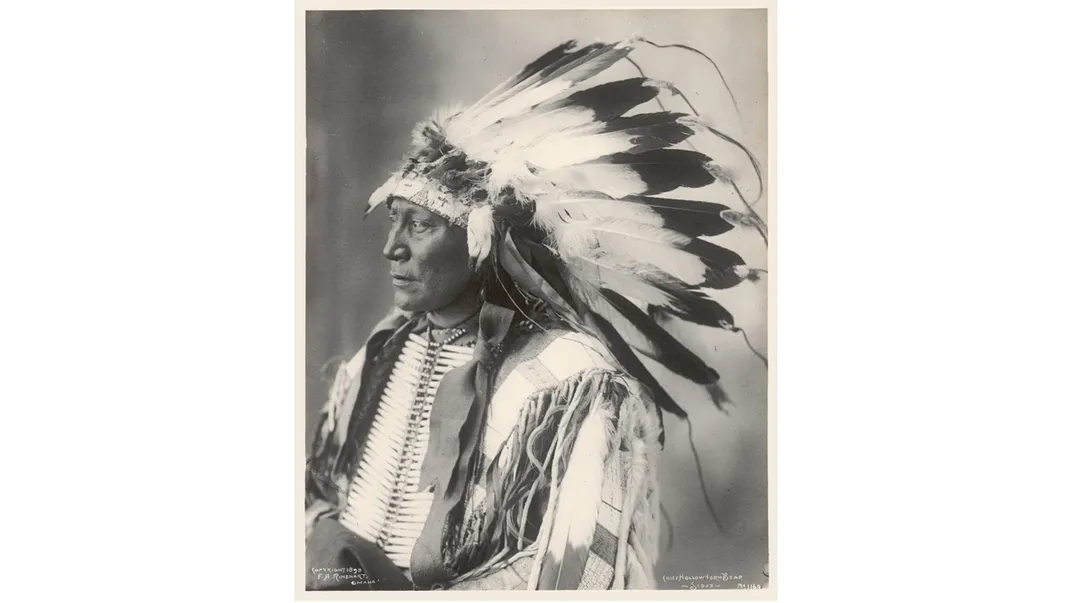NATIONAL MUSEUM OF THE AMERICAN INDIAN
144 Years after the Battle of Little Bighorn, Lakota Values Endure
On June 25 and 26, 1876, warriors of the Lakota, Cheyenne, and Arapaho nations defeated Lt. Colonel George Armstrong Custer and the U.S. Army’s 7th Cavalry at the Battle of Little Bighorn. Americans have always remembered the battle. What we often forget are the difficult decisions tribal leaders made afterward to ensure the safety of their people. The values that guided them then—generosity, perseverance, bravery, and wisdom—continue to serve the Lakota people today.
:focal(1214x1238:1215x1239)/https://tf-cmsv2-smithsonianmag-media.s3.amazonaws.com/blogging/featured/Strike_the_Kettle_Bighorn_Muslin_20-5176a.png)
For many Americans, the eagle feather headdress is a generic symbol of Native America indivisible from the narrative of the wild west and cowboys and Indians. For the Lakota, the wapaha is a symbol of cultural values, responsibility, and leadership. In order to wear a single eagle feather, a Lakota person must earn the right to do so. As Lakota elder Duane Hollow Horn Bear explains in the video below, “Imbued in this man’s life must be characteristics of the values of our people, such as fortitude, perseverance, generosity, bravery. And when he wears this, he must always think of the people as a whole.”
It has been 144 years since June 25 and 26, 1876, when the Lakota, Cheyenne, and Arapaho defeated Lt. Colonel George Armstrong Custer and the U.S. Army’s 7th Cavalry at the Battle of Little Bighorn. We remember the bravery of the victors, who responded to a surprise attack and utterly annihilated Custer and his troops in a last push to secure their homelands. What we often forget are the difficult decisions leaders like Sitting Bull (Hunkpapa Lakota), Hollow Horn Bear (Sicangu Lakota), American Horse (Oglala Lakota), Gall (Hunkpapa Lakota), Crazy Horse (Oglala Lakota), and others had to make to ensure the safety of their people following the battle. There weren’t only warriors camped at the Little Bighorn River; there were women and children, too. And almost immediately, these leaders had to decide what to do next to protect their people. Some, like Sitting Bull and Gall, fled to Canada, where they knew their people would be protected from further attacks by the U.S. Army. Others, like American Horse and Crazy Horse, stayed and continued to fight. Ultimately, all surrendered, were imprisoned, or were killed. Within less than a year following the battle, the United States had confined to reservations all of its Plains Indian adversaries.

For the Lakota, the core values of wówačhaŋtognaka (generosity), wówačhiŋtȟaŋka (perseverance), wóohitike (bravery), and wóksape (wisdom) are exemplified in leadership. At the time of the Battle of Little Bighorn, leaders were selected from headmen called wicasas, or shirtwearers, who represented each of the seven divisions of the Lakota. Four were selected among the wicasas to serve as leaders for the people as a governing council. Much has changed since that time, but these values have endured through individual tribal members and leaders alike.
These cultural values have helped the Lakota people and their tribal governments persevere through the 20th century and into the 21st. This spring, in response to the Covid-19 pandemic, Cheyenne River Sioux Chair Harold Frazier and Oglala Sioux Tribal President Julian Bear Runner made news by defying an order from South Dakota Governor Kristi Noem to remove public health checkpoints established by the tribes on highways crossing their respective reservations to protect tribal citizens and others.
Indianz.com and others have reported that Governor Noem and the Bureau of Indian Affairs (BIA) are asserting that the checkpoints violate a BIA memorandum that requires tribes to consult with state officials before “closing or restricting travel on state or U.S. highways.”
Both Chairman Frazier and President Bear Runner insist that they have not closed any roads but are using the checkpoints to mitigate and track the spread of the coronavirus.
“Non-residents whose travel is considered non-essential are advised to pass through the reservation without stopping,” wrote President Bear Runner to Noem. “It is not our intent to deny them passage through the reservation.”
A group of state legislators from both sides of the political aisle has written to Governor Noem supporting the tribes and saying that South Dakota “has no jurisdiction over the highways running through Indian lands in the state without tribal consent,” citing the 1851 Treaty of Horse Creek and 1868 Fort Laramie Treaty.
Prior to the Battle of Little Bighorn, American Horse and Iron Shell (father of Hollow Horn Bear), along with many other tribal leaders, signed the 1868 Fort Laramie Treaty to guarantee the sovereignty, well-being, and lands of the Lakota for future generations. More than 150 years later, their choices continue to provide protection for their people and the value of wówačhiŋtȟaŋka, or perseverance, continues to guide the decisions of Lakota leaders today.
The exhibition Americans explores how the Battle of Little Bighorn has influenced Americans’ ideas not only about American Indians but about our national character. A dialogue toolkit for Americans, created in collaboration with the International Coalition of Sites of Conscience, is also available on the museum’s website. The museum’s education initiative Native Knowledge 360° includes lesson plans on Northern Plains treaties and the meaning homelands, kinship systems, and nationhood hold for Native peoples of the Northern Plains.
Mandy Van Heuvelen (Mnicoujou Lakota and member of the Cheyenne River Sioux Tribe) is the Cultural Interpreter coordinator for the National Museum of the American Indian.
Duane Hollow Horn Bear (Sicangu Lakota) is a longtime member of the Lakota Studies Department at Sinte Gleska University on the Rosebud Indian Reservation and a great-grandson of Chief Hollow Horn Bear.
